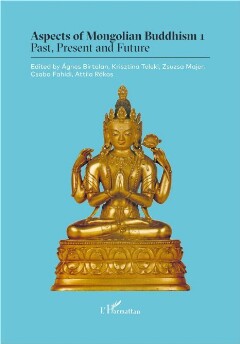Page 143 [143]
AGWANGKHAIDUB ON PsYcHIc HEAT, MOUNTAIN DIRT, AND VIRTUOUS SUBJECTS
pilgrims as they moved to encounter Maitreya images in the city and Maitreya Buddha
himself in their devotions.'* Here, as always with Agwangkhaidub’s works, the pilgrims
to whom he writes are directed to not only become liberated Buddhist practitioners,
but also virtuous subjects of the Oing formation."
Unfortunately there is no space to develop a broader comparative study of Agwang¬
khaidub as one ofthe great urban ideologues of Qing-era Inner Asia. It is my hope that
such a study — necessarily approached from across the porous boundaries of analytical
fields such as art history, material religion, performance theory, and Buddhist Studies
—may soon develop as a collaborative project. For the remainder of this article I turn
to “A Praise to the Sacred Place of Drépung Trashi Tsépel Ling” (Tib. ‘Bras spungs
bkra shis tshe ‘phel gling gi gnas bstod).'‘ This text is different from many of Ag¬
wangkhaidub’s other works on Yeke-yin Küriy-e in that it does not carefully measure,
demarcate, or route the material spaces and objects of the city. Nor does it prescribe
a particular mode of encounter and interaction with those spaces and objects. Instead,
it unravels a rich, if pithy, ode to the landscape surrounding this monastery using the
evocative, esoteric terminology and symbols of a body mandala.
A body mandala is an important subset of tantric self-cultivation according to many
Highest Yoga Tantra traditions (Skr. Anuttarayogatantra).'’ Here, the yogin first dis¬
solves ordinary appearances into emptiness (Skr. siinyata) as an imaginative rehearsal
of the death experience, before transforming, by means of systematic visualization, his/
her ordinary, impure, samsaric gross and subtle body into a purified, already enlight¬
ened form of a tantric Buddha (usually with consort) as an imaginative transforma¬
tion of the natural processes associates with the intermediate state and rebirth. Here
4 de Certeau, Michel — Giard, Luce — Mayol, Pierre: L'’Invention Du Quotidien. Nouv. éd. /, 2 vols., Col¬
lection Folio/Essais; Gallimard, [Paris?] 1990.
Ngag dbang mkhas grub: Byams pa’i dam bca’i gzungs bzla tshul. In: Collected Works of Kyai-rdor
Mkhan-po Ngag-dbang-mkhas-grub, vol. 1, 5 vols. S. W. Tashigangpa, Leh 1972, pp. 281-286; Ngag
dbang mkhas grub: Rgyal ba byams mgon gyi ‘dra sku’i nang du ‘bul rgyu’i ‘dod gsol dgos ‘dod yid
bzhin ‘gugs pa’i lcags kyu. In: Collected Works of Kyai rdor Mkhan-Po Ngag-dbang-mkhas-grub, vol. 1,
5 vols. S. W. Tashigangpa, Leh 1972, pp. 275-280; Ngag dbang mkhas grub: Rgyal ba byams mgon gyi
gsol ‘debs byams mgon zhal bzang Ita ba’i dga’ ston. In: Collected Works of Kyai-rdor Mkhan-po Ngag¬
dbang-mkhas-grub, vol. 1, 5 vols. S.W. Tashigangpa, Leh 1972, pp. 155-166; Ngag dbang mkhas grub:
Rgyal ba byams pa’i sgrub thabs dang ‘brel ba’i mchod chog dga’ Idan pad mtshor ‘jug pa’i gru gzings.
In: Collected Works of Kyai-rdor Mkhan-po Ngag-dbang-mkhas-grub, vol. 1,5 vols. S. W. Tashigangpa,
Leh 1972, pp. 121-154; Ngag dbang mkhas grub: Khu re chen mor bzhengs pa’i byams pa’i sku brnyan
gyi dkar chag dad pa’i bzhin ras gsal bar byed pa’i nor bu’i me long. In: Collected Works of Kyai-rdor
Mkhan-po Ngag-dbang-mkhas-grub, vol. 1, 5 vols. S. W. Tashigangpa, Leh 1972, pp. 175-274.
Ngag dbang mkhas grub: ’bras spungs bkra shis tshe ‘phel gling gi gnas bstod. In: Collected Works of
Kyai-Rdor Mkhan-Po Ngag-Dbang-Mkhas-Grub, vol. 5 (ca), 5 vols. S.W. Tashigangpa, Leh 1972, pp.
399-404.
As in most Géluk traditional presentations of this late period, the several sub-lineages of the three body
mandalas of Guhyasamaja, Cakrasamvara, and Yamantaka were the most popular Highest Yoga Tantric
systems, with the body mandala practice of Vajrayogini of almost equal importance and popularity (but
generally left outside of the orthodox triumvirate of the former three).
15
141

